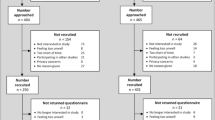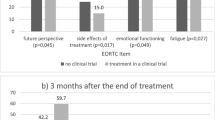Abstract
The objectives of this study were to compare health-related quality of life (HRQOL) between multiple myeloma (MM) patients aged ≤65 and >65 years and to compare this with a normative population. Factors associated with HRQOL were identified. The population-based Eindhoven Cancer Registry was used to select MM patients diagnosed from 1999 to 2010. Patients (n = 289) were invited to complete the European Organisation for Research and Treatment of Cancer Quality of Life Questionnaire Core 30 (EORTC QLQ-C30) and Quality of Life Questionnaire Multiple Myeloma Module 20 (QLQ-MY20), and 212 patients responded (73 %). Data from the normative population (n = 568) were used for comparison. MM patients >65 years scored better on emotional functioning (p < 0.05) and financial problems (p < 0.01) compared to patients ≤65 years. Patients ≤65 years reported better body image and future perspective (p < 0.01). Compared to the normative population, patients ≤65 years scored worse on all EORTC QLQ-C30 functioning scales and on global health/QOL, fatigue, pain, dyspnea, appetite loss, and financial problems (p < 0.01). Patients >65 years scored worse on social, physical, and role functioning and on global health/QOL, fatigue, pain, and dyspnea (p < 0.01). Younger patients had worse HRQOL compared to the normative population than elderly patients. Patients with comorbidities reported lower QOL. The longer the time since diagnosis, the better the physical functioning. No major differences in HRQOL were found between younger and older MM patients. Compared to that of the normative population, HRQOL in younger patients was worse than that in older patients. The number of comorbidities and time since diagnosis were associated with HRQOL. MM patients reported that a high symptom burden and therapy should, besides prolonging survival, be aimed at improving HRQOL.




Similar content being viewed by others
References
Surveillance, Epidemiology, and End Results Program. http://seer.cancer.gov/statfacts/html/mulmy.html
Attal M, Harousseau JL, Stoppa AM et al (1996) A prospective, randomized trial of autologous bone marrow transplantation and chemotherapy in multiple myeloma. Intergroupe Francais du Myelome. N Engl J Med 335:91–97
Child JA, Morgan GJ, Davies FE et al (2003) High-dose chemotherapy with hematopoietic stem-cell rescue for multiple myeloma. N Engl J Med 348:1875–1883
Fermand JP, Katsahian S, Divine M et al (2005) High-dose therapy and autologous blood stem-cell transplantation compared with conventional treatment in myeloma patients aged 55 to 65 years: long-term results of a randomized control trial from the Group Myelome-Autogreffe. J Clin Oncol Off J Am Soc Clin Oncol 23:9227–9233
Qazilbash MH, Saliba RM, Hosing C et al (2007) Autologous stem cell transplantation is safe and feasible in elderly patients with multiple myeloma. Bone Marrow Transplant 39:279–283
Muta T, Miyamoto T, Fujisaki T et al (2013) Evaluation of the feasibility and efficacy of autologous stem cell transplantation in elderly patients with multiple myeloma. Intern Med 52:63–70
Siegel DS, Desikan KR, Mehta J et al (1999) Age is not a prognostic variable with autotransplants for multiple myeloma. Blood 93:51–54
Palumbo A, Bringhen S, Petrucci MT et al (2004) Intermediate-dose melphalan improves survival of myeloma patients aged 50 to 70: results of a randomized controlled trial. Blood 104:3052–3057
Badros A, Barlogie B, Siegel E et al (2001) Autologous stem cell transplantation in elderly multiple myeloma patients over the age of 70 years. Br J Haematol 114:600–607
Facon T, Mary JY, Hulin C et al (2007) Melphalan and prednisone plus thalidomide versus melphalan and prednisone alone or reduced-intensity autologous stem cell transplantation in elderly patients with multiple myeloma (IFM 99–06): a randomised trial. Lancet 370:1209–1218
Palumbo A, Bringhen S, Caravita T et al (2006) Oral melphalan and prednisone chemotherapy plus thalidomide compared with melphalan and prednisone alone in elderly patients with multiple myeloma: randomised controlled trial. Lancet 367:825–831
Fayers PM, Palumbo A, Hulin C et al (2011) Thalidomide for previously untreated elderly patients with multiple myeloma: meta-analysis of 1685 individual patient data from 6 randomized clinical trials. Blood 118:1239–1247
Wijermans P, Schaafsma M, Termorshuizen F et al (2010) Phase III study of the value of thalidomide added to melphalan plus prednisone in elderly patients with newly diagnosed multiple myeloma: the HOVON 49 Study. J Clin Oncol Off J Am Soc Clin Oncol 28:3160–3166
Hulin C, Facon T, Rodon P et al (2009) Efficacy of melphalan and prednisone plus thalidomide in patients older than 75 years with newly diagnosed multiple myeloma: IFM 01/01 trial. J Clin Oncol Off J Am Soc Clin Oncol 27:3664–3670
San Miguel JF, Schlag R, Khuageva NK et al (2008) Bortezomib plus melphalan and prednisone for initial treatment of multiple myeloma. N Engl J Med 359:906–917
Mateos MV, Richardson PG, Schlag R et al (2010) Bortezomib plus melphalan and prednisone compared with melphalan and prednisone in previously untreated multiple myeloma: updated follow-up and impact of subsequent therapy in the phase III VISTA trial. J Clin Oncol Off J Am Soc Clin Oncol 28:2259–2266
Palumbo A, Hajek R, Delforge M et al (2012) Continuous lenalidomide treatment for newly diagnosed multiple myeloma. N Engl J Med 366:1759–1769
Mols F, Oerlemans S, Vos AH et al (2012) Health-related quality of life and disease-specific complaints among multiple myeloma patients up to 10 yr after diagnosis: results from a population-based study using the PROFILES registry. Eur J Haematol 89:311–319
Gulbrandsen N, Hjermstad MJ, Wisloff F, Nordic Myeloma Study G (2004) Interpretation of quality of life scores in multiple myeloma by comparison with a reference population and assessment of the clinical importance of score differences. Eur J Haematol 72:172–180
Verelst SG, Termorshuizen F, Uyl-de Groot CA et al (2011) Effect of thalidomide with melphalan and prednisone on health-related quality of life (HRQoL) in elderly patients with newly diagnosed multiple myeloma: a prospective analysis in a randomized trial. Ann Hematol 90:1427–1439
Delforge M, Dhawan R, Robinson D Jr et al (2012) Health-related quality of life in elderly, newly diagnosed multiple myeloma patients treated with VMP vs. MP: results from the VISTA trial. Eur J Haematol 89:16–27
Dimopoulos MA, Delforge M, Hajek R et al (2013) Lenalidomide, melphalan, and prednisone, followed by lenalidomide maintenance, improves health-related quality of life in newly diagnosed multiple myeloma patients aged 65 years or older: results of a randomized phase III trial. Haematologica 98:784–788
Fritz A, Percy C, Jack A et al (2000) International classification of diseases for oncology, 3rd edn. World Health Organisation, Geneva
van de Poll-Franse LV, Horevoorts N, van Eenbergen M et al (2011) The Patient Reported Outcomes Following Initial treatment and Long term Evaluation of Survivorship registry: scope, rationale and design of an infrastructure for the study of physical and psychosocial outcomes in cancer survivorship cohorts. Eur J Cancer 47:2188–2194
van de Poll-Franse LV, Mols F, Gundy CM et al (2011) Normative data for the EORTC QLQ-C30 and EORTC-sexuality items in the general Dutch population. Eur J Cancer 47:667–675
Aaronson NK, Ahmedzai S, Bergman B et al (1993) The European Organization for Research and Treatment of Cancer QLQ-C30: a quality-of-life instrument for use in international clinical trials in oncology. J Natl Cancer Inst 85:365–376
Cocks K, Cohen D, Wisloff F et al (2007) An international field study of the reliability and validity of a disease-specific questionnaire module (the QLQ-MY20) in assessing the quality of life of patients with multiple myeloma. Eur J Cancer 43:1670–1678
Sangha O, Stucki G, Liang MH, Fossel AH, Katz JN (2003) The Self-Administered Comorbidity Questionnaire: a new method to assess comorbidity for clinical and health services research. Arthritis Rheum 49:156–163
Cocks K, King MT, Velikova G, Martyn St-James M, Fayers PM, Brown JM (2011) Evidence-based guidelines for determination of sample size and interpretation of the European Organisation for the Research and Treatment of Cancer Quality of Life Questionnaire Core 30. J Clin Oncol Off J Am Soc Clin Oncol 29:89–96
Osoba D, Rodrigues G, Myles J, Zee B, Pater J (1998) Interpreting the significance of changes in health-related quality-of-life scores. J Clin Oncol Off J Am Soc Clin Oncol 16:139–144
Kyle RA, Gertz MA, Witzig TE et al (2003) Review of 1027 patients with newly diagnosed multiple myeloma. Mayo Clin Proc 78:21–33
van der Poel MW, Oerlemans S, Schouten HC, et al (2013) Quality of life more impaired in younger than in older diffuse large B cell lymphoma survivors compared to a normative population: a study from the population-based PROFILES registry. Annals of Hematology
Mols F, Thong MS, Vissers P, Nijsten T, van de Poll-Franse LV (2012) Socio-economic implications of cancer survivorship: results from the PROFILES registry. Eur J Cancer 48:2037–2042
Goodwin JA, Coleman EA, Sullivan E et al (2013) Personal financial effects of multiple myeloma and its treatment. Cancer Nurs 36:301–308
Kleber M, Ihorst G, Terhorst M et al (2011) Comorbidity as a prognostic variable in multiple myeloma: comparative evaluation of common comorbidity scores and use of a novel MM-comorbidity score. Blood Cancer J 1:e35
Kleber M, Ihorst G, Gross B et al (2013) Validation of the Freiburg Comorbidity Index in 466 multiple myeloma patients and combination with the international staging system are highly predictive for outcome. Clin Lymphoma Myeloma Leuk 13:541–551
Dimopoulos MA, Palumbo A, Hajek R, et al (2013) Factors that influence health-related quality of life in newly diagnosed patients with multiple myeloma aged >/= 65 years treated with melphalan, prednisone and lenalidomide followed by lenalidomide maintenance: results of a randomized trial. Leukemia & Lymphoma
Gulbrandsen N, Wisloff F, Brinch L et al (2001) Health-related quality of life in multiple myeloma patients receiving high-dose chemotherapy with autologous blood stem-cell support. Med Oncol 18:65–77
Acknowledgments
We thank all patients and their doctors for their participation in the study. Special thanks go to Dr. M. van Bommel for independent advice and answering questions of patients. The following hospitals provided cooperation: Catharina Hospital, Eindhoven; Jeroen Bosch Hospital, ‘s-Hertogenbosch; Maxima Medical Centre, Eindhoven and Veldhoven; Sint Anna Hospital, Geldrop; St. Elisabeth Hospital, Tilburg; Twee Steden Hospital, Tilburg; VieCuri Hospital, Venlo and Venray; and Hospital Bernhoven, Oss.
Funding
This work was supported by the Jonker-Driessen Foundation and ZonMW: the Netherlands Organisation for Health Research and Development and through PHAROS: Population-based HAematological Registry for Observational Studies (#80-82500-98-01007). Dr. Lonneke van de Poll-Franse is supported by a Cancer Research Award from the Dutch Cancer Society (#UVT-2009-4349).
This study has been approved by the appropriate ethics committee and has therefore been performed in accordance with the ethical standards laid down in the 1964 Declaration of Helsinki and its later amendments.
Informed consent was obtained from all patients for being included in the study.
Conflict of interest
The authors declare that they have no conflicts of interest.
Author information
Authors and Affiliations
Corresponding author
Rights and permissions
About this article
Cite this article
van der Poel, M.W.M., Oerlemans, S., Schouten, H.C. et al. Elderly multiple myeloma patients experience less deterioration in health-related quality of life than younger patients compared to a normative population: a study from the population-based PROFILES registry. Ann Hematol 94, 651–661 (2015). https://doi.org/10.1007/s00277-014-2264-0
Received:
Accepted:
Published:
Issue Date:
DOI: https://doi.org/10.1007/s00277-014-2264-0




